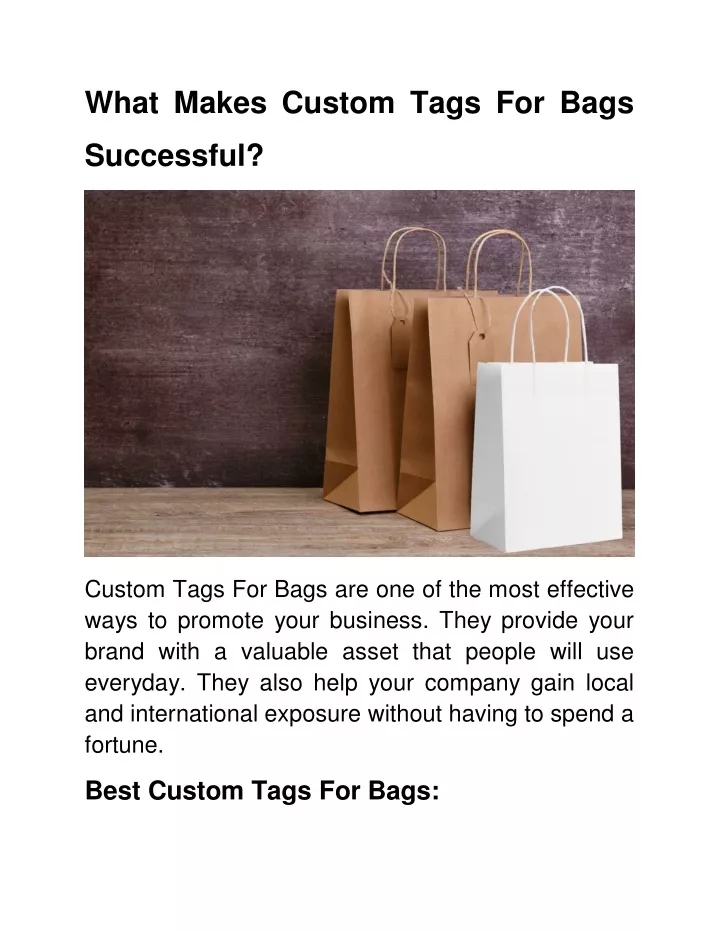How To Create Custom Tags For Bags That Stand Out

In the vast marketplace of fashion accessories, custom tags for bags emerge like sirens in the night, beckoning attention and creating a connection. These small yet potent add-ons serve not merely as identifiers but as storytellers of their own. They encapsulate a brand's essence, evoke emotions, and ignite curiosity. Crafting tags that stand out is an art in itself, one that requires a delicate fusion of creativity and strategy. Let’s delve into the intricate tapestry of designing custom tags for bags that resonate deeply with consumers.
First and foremost, understanding the purpose of a custom tag is essential. Imagine a tag as a postcard from the brand to the customer. It embodies the story, vision, and unique character of the product. A tag can convey the sustainability efforts behind the bag, the inspiration for its design, or even a whimsical touch of humor. The goal is to transcend beyond functionality, transforming the tag into a captivating narrative that entices potential buyers.
One of the foundational elements in creating a standout tag is visual appeal. Think of color as the heartbeat of a tag; it pulsates with energy and draws in the eyes. Utilizing colors that align with the brand’s identity can evoke specific emotions. For instance, vibrant hues can signify excitement and youthfulness, whereas muted tones may communicate elegance and sophistication. Carefully selecting a color palette that complements the bag's aesthetic while remaining distinct can make a world of difference.
Next comes typography. The font chosen for the text on the tag acts like a voice. Is it loud and bold, or soft and inviting? The typography should not only be legible but also reflect the personality of the brand. Gourmet brands may opt for elegant serif fonts, while modern, casual brands might favor clean sans-serif styles. The interplay between font choice and the tag’s design can evoke styles ranging from rustic charm to urban chic.
Adding texture is another way to elevate a custom tag from mundane to magnificent. The substrate upon which a tag is printed can significantly impact its tactile quality. A velvety finish can tantalize the fingertips, while a sleek, glossy surface draws the eye. Consider incorporating unique materials, such as recycled paper, wood, or even fabric. Every texture tells a story; it crafts an experience that lingers long after the bag has been purchased.
Incorporating innovative shapes is also an exciting way to differentiate a tag. While rectangular tags are a staple, venturing into non-traditional silhouettes can create intrigue. Think of playful shapes that mirror the bag’s design elements. A tag shaped like a flower for a floral-patterned tote or a leaf for eco-friendly bags adds whimsical flair that captures attention. Such creativity transforms the tag into an extension of the product itself—a delightful surprise waiting to be discovered.
Next, delve into the content of the tag. Brevity is crucial; a tag should communicate its message succinctly yet powerfully. A clever tagline or catchy phrase can be memorable, linking the bag to the consumer's emotions. However, ensure that the message aligns with your brand ethos. If the bag represents adventure, a line like “Unleash your wanderlust” can resonate deeply, encouraging customers to envision their journeys filled with excitement.
Don’t overlook the element of storytelling. Infusing a narrative element into the tag can transform it into an engaging experience. Consider including a QR code that links to a video showcasing the making of the bag or a personal note from the designer. This not only highlights craftsmanship but also creates a bond between the buyer and the bag’s origin. When customers feel connected to the story, they’re more likely to cherish the product.
Moreover, sustainability has become paramount in today’s consumer culture. Emphasizing eco-friendly practices on the tag can significantly boost its appeal. Highlighting the use of sustainable materials or the processes involved in the creation of the bag engages environmentally-conscious consumers. A tag that proudly proclaims “Made with recycled materials” or “Handcrafted with care” reflects social responsibility, inviting customers to be part of a cause they care about.
Lastly, consider the presentation of the tag. A beautifully packaged tag attached to a bag can elevate the unboxing experience, making it feel like a celebration. Using custom strings, clips, or even removable embellishments like charms can create a multi-sensory experience. When customers open a bag and discover a thoughtful, well-presented tag, it enhances their overall perception of the brand.
To conclude, creating custom tags for bags that stand out is an intricate alchemy of design, storytelling, and branding. Each element, from color and typography to texture and sustainability, contributes to the tapestry of a tag’s narrative. It is about weaving a tale that resonates, engages, and leaves a lasting imprint. As you embark on this creative journey, let your tags not only be markers of identity but also vessels of emotion and connection in the bustling world of fashion accessories.
Post a Comment for "How To Create Custom Tags For Bags That Stand Out"